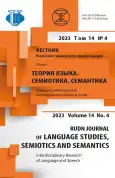Semantic Transformations of the Lexeme Икона in the Russian Language of the Newest Period
- Authors: Shkapenko T.M.1, Vaulina S.S.1
-
Affiliations:
- Immanuel Kant Baltic Federal University
- Issue: Vol 14, No 4 (2023): INTERDISCIPLINARY RESEARCH OF LANGUAGE AND SPEECH
- Pages: 1139-1153
- Section: SEMIOTICS. SEMANTICS. PAREMIOLOGY
- URL: https://journal-vniispk.ru/2313-2299/article/view/323623
- DOI: https://doi.org/10.22363/2313-2299-2023-14-4-1139-1153
- EDN: https://elibrary.ru/CHRWFE
- ID: 323623
Cite item
Full Text
Abstract
The study focuses on the analysis of semantic changes of the lexeme икона , considered in a synchronous-diachronic perspective. The relevance of the study is determined by its implementation in an interdisciplinary, linguo-philosophical, as well as a contrastive, Russian-English paradigm. This ensures the objectivity of conclusions about the causes and consequences of neosemantization of the word икона in modern Russian. Proceeding from the study of lexicographic data, illustrative material of the National Corpus of the Russian Language and open Internet resources, it is proved that the emergence of new lexical-semantic variants of the noun икона is the result of semantic borrowings from the English language. The appearance in the English word icon of terminological meanings relating to the field of semiotics and computer technology is based on the concretization of the primary meaning “image, likeness”, in which it was borrowed from the Greek language. The emergence of a new lexical-semantic variant “idol, idol of the masses” in the semantic structure of the word icon is based on the actualization of the potential seme “symbol”. The use of this meaning in relation to various celebrities of pop culture leads to the positioning of icons of style, fashion and sex symbols at the highest levels of the value hierarchy of the consumer society. Anglo-American linguoconcepts penetrate into the modern Russian language as a result of calquing the lexical units from English-language publications. Despite the functioning of the lexical units икона стиля, моды, фэшн-икона and the word икона in the meaning of a religious artifact in different types of discourses, the presence of a common seme «object of worship» causes their semantic diffusion. The parallel use of the word икона in relation to diametrically opposed objects of sacralisation leads to a linguoaxiological clash of “own” and “strange” spheres. The result of this collision is the desacralisation of the concept икона in the national language consciousness.
About the authors
Tatiana M. Shkapenko
Immanuel Kant Baltic Federal University
Author for correspondence.
Email: tshkapenko@kantiana.ru
ORCID iD: 0000-0002-6892-4205
D.Sc. in Philology, Associate Professor, Professor of the Institute for the Humanities
14 Alexander Nevsky str., Kaliningrad, Russian Federation, 236041Svetlana S. Vaulina
Immanuel Kant Baltic Federal University
Email: svaulina@mail.ru
ORCID iD: 0000-0001-7109-2836
D.Sc. in Philology, Professor, Professor of the Institute for the Humanities
14 Alexander Nevsky str., Kaliningrad, Russian Federation, 236041References
- Petrukhina, E.V. (2018). The Processes of Desacralization of Vocabulary in the Russian Language: the role of derivational formants. Russian language in a multicultural world. Moscow. pp. 238-248. (In Russ.).
- Kayua, R. (2003). Myth and Man. Man and the Sacred. Moscow: OGI Publ. (In Russ.).
- Kudashov, V.I. & Burtasova, N.S. (2015). Sacralisation of Ideals and Values in Management of the Mass Consciousness. Journal of Siberian Federal University. Humanitiees and Social Scienses, 8(5), 1011-1021. (In Russ.).
- Shirokova, M.S. (2010). Some Features of Desacralization as the Main Structure-forming Mechanism of the Elements of the Church Worldview (on the Example of Concepts of Sacrifice and Prayer). Vestnik NSU. Series: History and Philology, 9(2), 13-19. (In Russ.).
- Shkuran, О.V. (2019). Language units with sacred semantics: linguocultural and lexicographic aspects. RUDN Journal of Language Studies, Semiotics and Semantics, 10(2), 336-352. https://doi.org/10.22363/2313-2299-2023-10-2-336-352 (In Russ.).
- Obmorokova, A.M. & Nemaeva, N.O. (2016). Orthodox artistic culture as a traditional means of sacralization of basic social ideals. Journal of Siberian Federal University. Humanities and Social Sciences, 9(2), 394-405.
- Paducheva, E.V. (2004). Dynamic Models in the Semantics of Vocabulary. Moscow: Languages of Slavic culture. (In Russ.).
- Shkapenko, T.M. & Vaulina, S.S. (2020). Problems of Terminology and Theoretical Description of Language Derivation Levels. Science Journal of VolSU. Linguistics, 19(6), 204-215. https://doi.org/10.15688/jvolsu2.2020.6.16 (In Russ.).
- Belov, V.A. (2020). Semantic Derivation of Nouns. Tomsk State University Journal, 459, 5-14. (In Russ.).
- Vasilieva, G.M. (2023). Ecology: Dynamics of semantic changes of the word in the mirror of Russian explanatory dictionaries of the 20th - early 21st centuries. Russian Journal of Lexicography, 29, 71-86. https://doi.org/10.17223/22274200/29/4 (In Russ.).
- Witalisz, A. (2007). Anglosemantisms in Polish Language. Kraków: Tertium Publ. (In Polish).
- Bugaeva, I.V. (2016). Concept I con in Russian Language Picture of the World. Proceedings of the Southwest State University. Series: Linguistics and Pedagogics, 3(20), 13-20. (In Russ.).
- Mordovina, L.V. & Shilova, A. (2009). The Phenomenon of Mass Culture in Modern Society. Analytics of Cultural Studies, 2(14), 133-134. (In Russ.).
- Yakovleva, E.L. (2017). Modern transformations: from paganism to (post) neo-paganism (on the example of glamorous social). Sociodynamics, 2, 91-100. (In Russ.).
- Dąb-Kalinowska, B. (2000). Ikons and Images. Warsaw: DIG Publ. (In Polish).
- Schmidt, V.V. (2011). On the sign and symbol in religion and society in the aspects of interinstitutional dialogue. Religious Studies, 3, 69-74. (In Russ.).
Supplementary files









